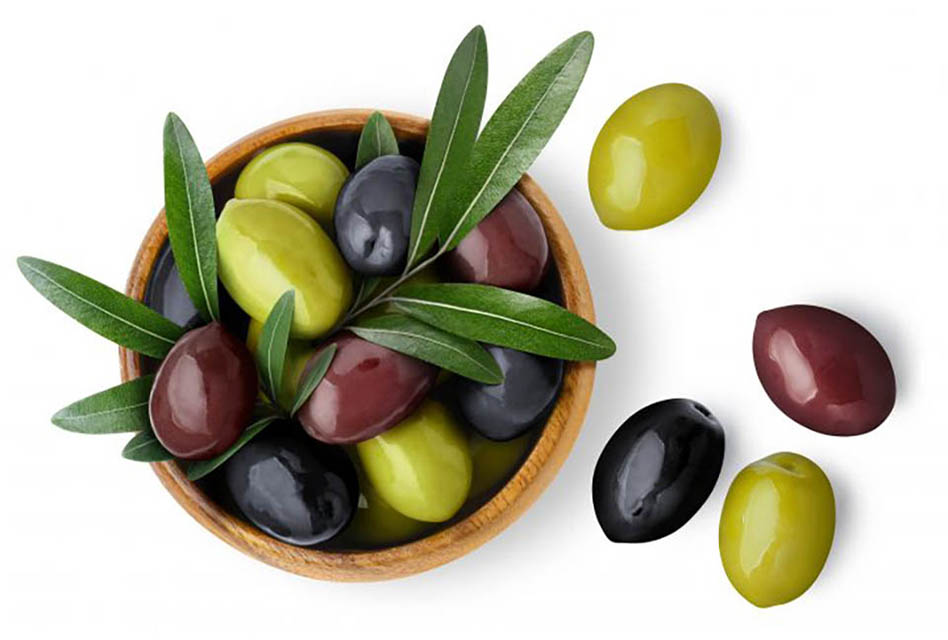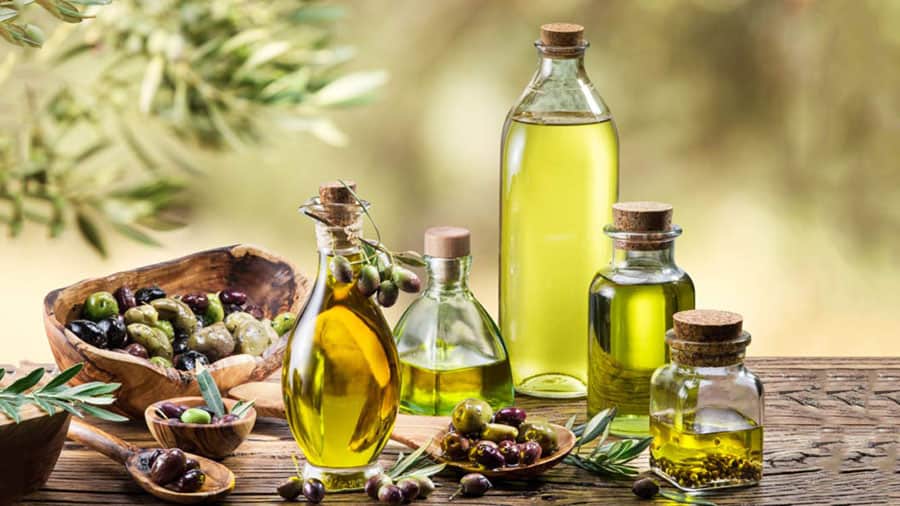Greek Table Olives – TASTE ATLAS: 21 varieties of Greek table olives rank among the best 50 worldwide
21 Greek Table Olives varietes rank among the best in the world
21 of the 50 best table olives in the world, are produced in Greece – 8 Greek Table Olives rank in the top 10 best Table Olives
According to the latest online competition effectuated by the reputable TASTE ATLAS the majority of the table olives varieties worldwide that ranked in the top 50 were the Greek Table Olive varieties.
The Greek Table Olives
Agricultural products that Greece excel at worldwide, is its Extra Virgin Olive Oil, as well as the Greek Table Olives (beside Feta cheese and other types od diary products). Table Olives are rich in micronutrients and powerful antioxidants – their unique organoleptic properties and high nutritional value have increased table olive consumption worldwide.
What are the most famous products of Greece that give it a global strategic advantage? The feta cheese and the Greek Extra Virgin Olive Oil. These two are the dominant export products, so quite naturally in the Taste Atlas list of the best olives in the world, Greece dominates.
Of the 50 best table olive varieties included in the list, 21 positions concern table olives produced in Greece and the remaining 29 are distributed in the European south, with the only exception being one olive produced in Peru. Another 10 edible olives are from Spain, 8 from Italy, 6 from France, 3 from Portugal and one from Montenegro.
If this best table olives varieties list were extended to 100 varieties, then Greek table olives production varieties would easily have half of them.
Greek Table Olives Exports facts and numbers: According to the estimates of the 2020/2021 crop year, extra-EU exports of table olives reached 320.829 tonnes for an estimated value of €868,1 million (+8.6% and +4.6% respectively compared to the previous crop year). In November of the 2021/2022 crop year, the unit value of extra-EU exports stood at €281 per 100kg (+2.4% compared to the previous month).
Greek exports of table olives reached 191.965 tonnes and €551,4 million value – EXPORT FIGURES OF TABLE OLIVES IN THE EU-27
Today Greece exports about 90% of its table olive production
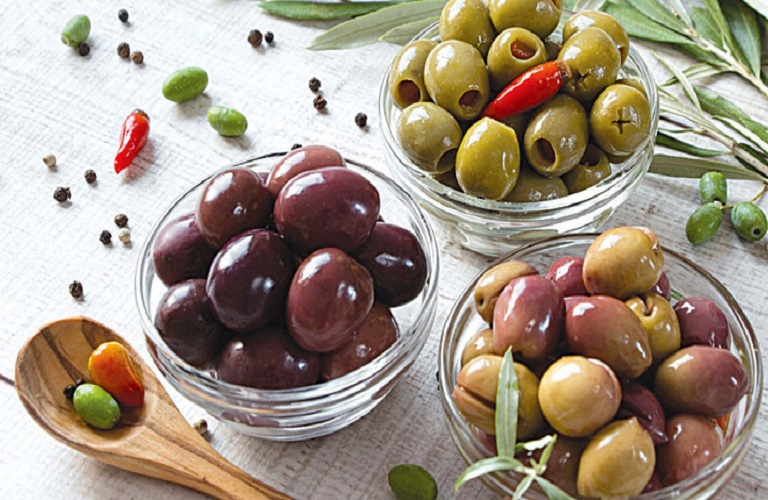
Out of the TOP 10 Table Olives worldwide 8 are Greek Table Olives - 21 of the 50 best table olives in the world are produced in Greece
This is the full list and the ranking number of the best Greek Table Olives varieties that are among the best 50 Table Olives worldwide
In detail, the Greek table olives varieties produced in Greece and are on the TasteAtlas’s Best Table Olives varieties list are:
1. Kalamata table olives – the most famous and popular table olives worldwide. Kalamata olives are large, dark, and juicy, with a mild flavour that enhances a wide range of dishes. They’re typically preserved in red wine vinegar, red wine, and/or olive oil for a distinctive rich, smoky, fruity flavor. Kalamata olives are ideal for salads, appetisers, as a topping for pizza. These edible olives are predominantly cultivated in the regions of Messenia and Laconia in the Peloponnese, Greece.

Kalamata Table Olives – Kalamon Olives
2. Green Olives of Halkidiki (Chalkidiki) – native to the Halkidiki region in northern Greece (region of Macedonia), Halkidiki green Table Olives are renowned for their large size, firm texture, and vibrant green color. These olives are handpicked while still unripe and have a distinctive, mildly tangy flavor with a subtle hint of bitterness. Chalkidiki olives are rich in antioxidants, they are prized for their health benefits and are commonly enjoyed in Mediterranean dishes, salads, or simply as a snack. Their exceptional quality makes them one of Greece’s most famous edible olive varieties. Their plumpness and meaty bite with a fruity, briny, buttery and pleasantly sour flavour make them a great table olive.

Halkidiki Green Table Olives
3. Thrompa Thassos – a traditional Greek variety hailing from the island of Thassos. These small, wrinkled black olives are naturally sun-dried on the tree, giving them a rich, robust flavor with a slightly sweet and salty profile. Known for their high nutritional value, they are often enjoyed as part of Mediterranean diets. Thrompa Thassos olives are celebrated for their unique texture and deep, earthy taste, making them a delicacy in Greek cuisine.
4. Koroneiki – known as the “queen” of oil olives, Koroneiki olives are small but packed with flavour. They have a fresh, fruity taste and are a key ingredient in about a third of all Greek olive oils. Rich in healthy fatty acids, these olives are primarily grown in the southern Peloponnese and on Crete.

Koroneiki Table Olives from Greece
5. Tsunatti – Tsunati table olives are a celebrated Greek variety, primarily grown in Crete. These olives are medium to large in size, with a rich, dark color and a smooth, slightly oily texture. Known for their mild, fruity flavor with a hint of bitterness, Tsunati olives are often used for both eating and producing high-quality olive oil. Their versatility and distinct taste make them a staple in the Greek cuisine.
6. Patrinia – Patrinia table olives, originating from the region around Patras in Greece, are prized for their smooth texture and rich, earthy flavor. These medium-sized olives are typically dark in color and have a well-balanced taste that combines a mild bitterness with a subtle sweetness. Often enjoyed in salads, appetizers, or as a snack.
7. Kolovi – Kolovi table olives, native to the island of Lesvos in Greece, grown in the island’s unique climate Kolovi olives are a cherished variety known for their medium size and firm texture. Typically dark in color, these edible olives have a rich, slightly fruity flavor with a hint of bitterness. They are a popular choice for both eating and olive oil production.
9. Thoumpa – the Thrumpa olive is a rustic gem from Greece, with its wrinkled, sun-dried skin and deep, earthy flavor that feels like a connection to ancient times. Unlike smoother varieties, Thrumpa olives undergo a natural curing process on the tree, absorbing the essence of the Aegean climate. Their unique texture – almost leathery – coupled with a savory, mellow taste, makes them stand out in a world of slick, brined olives. Perfect for those who appreciate a taste with history and character.
11. Thoumpa of Chios – Thrumpa olive of Chios is a unique Greek table olives variety, naturally dried on the tree, giving it a distinctively wrinkled texture and rich, concentrated flavor. Grown in the island’s nutrient-rich soil, these black olives offer a bold, slightly salty taste with earthy undertones. Known for their traditional curing method, they are a staple in Chios’ culinary culture. Grown in Chios’ island mineral-rich soil, these olives develop a deep, briny intensity as they dry on the tree, creating a bold taste that’s both rustic and refined. Their firm, almost chewy texture pairs beautifully with rich cheeses and rustic breads, offering an unfiltered taste of the Aegean landscape.
13. Kollyreiki – Kollyreiki table olives, native to the Peloponnese region of Greece, are a lesser-known yet prized variety. These medium-sized olives are distinguished by their smooth skin and balanced flavor, combining a mild bitterness with a touch of sweetness.
14. Asprolia – Asprolia table olives, originating from Greece, are a rare and delicate variety known for their light green color and mild, buttery flavor. These olives are picked early, capturing a subtle sweetness and low bitterness that sets them apart from more robust varieties. Asprolia olives are often enjoyed in salads or as a snack.
15. Dopia – the Dopia table olive is a prized table olives variety cultivated in Greece, particularly in the regions of Argolis and Arcadia. Known for its large size and meaty texture, the Dopia olive is often enjoyed as a table olive. It has a mild, slightly sweet flavor with low bitterness, making it appealing to a wide range of palates. The Dopia olive is typically harvested when fully ripe, resulting in a dark purple to black color and often cured in brine.
16. Agouromanako – these plump, hand-picked gems boast a rich, buttery flavor with a subtle hint of brine, perfectly balancing savory and tangy notes.
18. Conservolia of Rovia – nestled in the sun-drenched groves of Rovia, Conservolia Rovia olives are a testament to centuries-old tradition and unparalleled taste. These plump, emerald gems boast a delicate balance of brine and fruitiness, with subtle notes of herbs that dance on the palate. Carefully hand-picked and cured using time-honored methods, each olive embodies the region’s rich culinary heritage.
19. Lianolia of Corfu – Lianolia olive, native to the Greek island of Corfu, is a versatile variety used for both: its oil and is used as a table olive too. As a table olive, Lianolia is known for its small to medium size and distinctive oval shape. It offers a balanced flavor profile with a mild fruitiness and a hint of bitterness. Typically harvested when fully ripe, Lianolia table olives range in color from deep purple to black and is cured in brine.
20. Conservolia Stylidas – Conservolia Stylidas table olives stand out due to their unique organoleptic characteristics, which are enhanced by the region’s ideal climatic conditions. Grown primarily in Central Greece, these olives exhibit a rich, fruity flavor with hints of red wine, attributed to the natural yeast on their skins during processing in a sea salt brine. The olives are large and oval-shaped, with a firm yet tender flesh that separates easily from the pit, making them particularly appealing for table use. Additionally, the olives’ versatility allows them to be processed as both green and black varieties, catering to diverse culinary applications. Their resistance to shriveling and the specific harvesting techniques used further contribute to their distinct quality and flavor profile.
21. Conservolia Atalantis – the Conservolia Atalantis table olive is primarily cultivated in the region of Atalanti, Greece, where it thrives in the Mediterranean climate. The cultivation methods typically involve traditional farming practices, including hand-picking the olives at the peak of ripeness. This olive variety is characterized by its oval shape, deep purple to black color, firm texture, and mellow, nutty flavor. Its low bitterness and high oil content make it highly versatile for both table consumption and oil extraction. In culinary use, Conservolia Atalantis olives are often enjoyed also as a standalone snack, beside used in various dishes. What makes the Conservolia Atalantis table olive special is its unique flavor profile, high oil content, and the traditional cultivation methods used, all of which contribute to its exceptional taste and culinary versatility.
33. Conservolia Artas – The Conservolia Artas table olive is a variety known for its rich, meaty texture and vibrant flavor. Grown primarily in the region of Artas, Greece, these olives are revered for their unique taste and versatility. With a deep purple hue, they are often enjoyed as a standalone snack, or incorporated into salads, dips, or as a topping for pizzas and sandwiches. The Conservolia Artas olives are also commonly used to produce high-quality olive oil. The Conservolia Atalantis table olive is known for its distinct oval shape and mellow, slightly nutty flavor and its skin showcases a beautiful deep purple to black color. These olives are prized for their low bitterness and high oil content, making them ideal for both table consumption and oil extraction. The Conservolia Atalantis variety is typically harvested in late autumn to early winter.
34. Conservolia of Pelion – As interest in gourmet ingredients rises, the Conservolia of Pelion table olive stands out as a must-try for food enthusiasts. Conservolia of Pelion is a notable table olive cultivar known for its strong growth habit and high fruit weight, averaging around 4,63 grams per olive. This cultivar is characterized by its spherical shape and a significant number of pointed oval grooves on the fruit surface. It thrives in rain-fed agricultural conditions, displaying a hierarchical growth pattern. Although its oil content is relatively lower compared to some other varieties, the Conservolia table olive is particularly valued for its culinary uses due to its robust flavor and texture, making it a preferred choice for table olives.
35. Conservolia of Afissa – often referred to as Amfissa olives, Konservolia olives are a staple on Greek tables. While rarely used for oil, they are cherished for their crunchy and juicy texture. These olives are grown in central Greece and the northern region of Epirus, as well as on several Greek islands. Depending on the harvest time and ripeness, they can be green, transitioning, or black. Plucked from their branches when very ripe, they slowly brine cured to coax out a mild, fruity flavor and a melt-in-your-mouth softness. In Greece, Amfissa table olives are often served in soups or stews, but are also great beside cheeses and cured meats.
40. Thoumpa of Ambadia of Rethymnon – the Thoumpa table olives of Ambadia, a region in Rethymnon, Crete, is a unique variety celebrated for its naturally sun-dried, wrinkled appearance and deep, robust flavor. Grown in the rugged landscape of Ambadia, these olives are rich in earthy, briny notes, with a slightly sweet aftertaste that speaks to the traditional curing process they undergo on the tree. Thoumpa olives are a true reflection of Crete’s agricultural heritage and bold flavors and are often used in local dishes or enjoyed with bread and cheese.
Greece is home to several more renowned olive varieties, each with its own distinctive characteristics.
TasteAtlas is an experiential travel online guide for traditional food that collates authentic recipes, food critic reviews, and research articles about popular ingredients and dishes. Describing itself as “a world atlas of traditional dishes, local ingredients, and authentic restaurants”, it features an interactive global food map with dish icons shown in their respective regions and purportedly contains nearly 10.000 dishes, drinks, and ingredients, as well as 9.000 restaurants (SOURCE: Wikipedia)
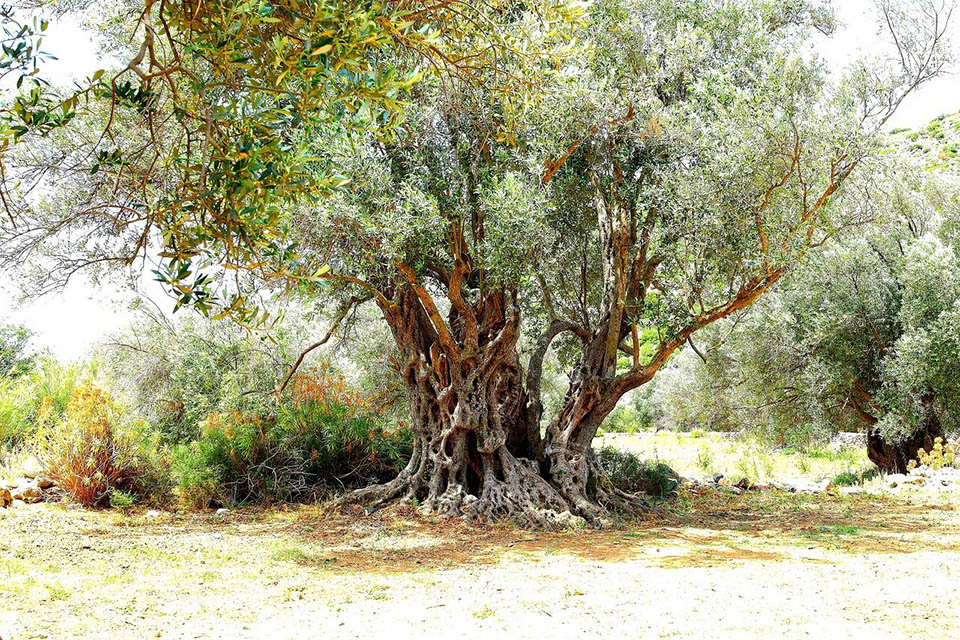
Differences and Uses Between Green Table Olives and Black Olives
Table Olives come in various types, each with distinct qualities. See how green and black olives differ.
What are Green Table Olives?
Green olives are the unripe fruit of olive trees harvested before ripening. To remove their natural bitterness, they are soaked in a lye solution before being brined. They are rich in antioxidants, healthy fats, and vitamins A and E. Common types of green olives include Halkidiki, Manzanilla and Picholine. These olives are often pitted and can be filled with ingredients like cheese, pimentos, jalapeños, capers, anchovies, or nuts.
Uses for Green Olives
Green olives are quite salty due to their high sodium content, making them a savory addition to many dishes. They can be eaten alone, added to salads or pasta, made into tapenade, or used as a garnish in martinis. Halkidiki green table olives are the most popular edible green olives in Greece and among the most popular worldwide.
What are Black Table Olives?
Black olives are fully ripe when picked, turning from green to shades of dark brown or black. After harvesting, they undergo curing, which may further darken their color. Like green olives, black olives are rich in monounsaturated fats, calcium, potassium, and vitamins E and A. Popular black olive varieties include Kalamata (Greek olives with a mild flavor and purple-brown hue) and Gaeta (Italian olives with a milder flavor, often confused with Kalamatas). Kalamata table olives (named after the city of Kalamata in the southern Peloponnese, Greece) are among the most popular and highly appraised table olives worldwide and have a mild flavor and purple-brown hue.
Uses for Black Olives
Black olives are commonly enjoyed as snacks or appetizers, and they make great additions to cheese boards and charcuterie plates. They’re often used as pizza toppings and add a tangy flavor to salads and pasta dishes. Black olives are always used in Greek Salad.
Green vs. Black Olives: Key Differences
Several factors distinguish green olives from black olives:
• Color: Green olives are green, while black olives can range from light brown to deep black, sometimes showing purple or brown tones.
• Flavor: Green olives have more sodium, making them saltier and more bitter compared to the milder black olives.
• Ripeness: Green olives are unripe when harvested, while black olives are picked after ripening.
• Processing: Green olives go through fermentation in a lye solution before brining, whereas black olives are cured immediately.
• Nutritional Value: Both types are nutritious, but green olives contain slightly more polyphenols, providing extra antioxidant and anti-inflammatory benefits.
Can You Substitute One for the Other?
Due to the flavor differences, green and black olives are not always interchangeable. If using olives as a snack, swapping one for the other works fine. However, if a recipe calls for a specific type, it’s best to use that variety for its distinct flavor. For instance, when substituting black olives for green ones, avoid overcooking them to preserve their taste. Similarly, green olives can be cooked to reduce bitterness, but be mindful of adjusting the salt level in your dish.
WORLD MARKET OF OLIVE OIL AND TABLE OLIVES – DATA FROM AUGUST 2024
The Table Olives market situation (data: AUGUST 2024)

Table Olives – international imports & export data – 2024
Imports of table olives have risen by 12.3% on the main markets since the start of the current crop year (September 2023 to June 2024). Imports from the United States have fallen by 2.7%, while imports from Brazil have risen by 3.6%.
The United States (US) imports an average of more than 150.000 tonnes of table olives per crop year. The main suppliers of table olives to the US are Spain (39%), Greece (25%) and Morocco (10%).
SOURCE: International Olive Council – https://www.internationaloliveoil.org/world-market-of-olive-oil-and-table-olives-data-from-august-2024/
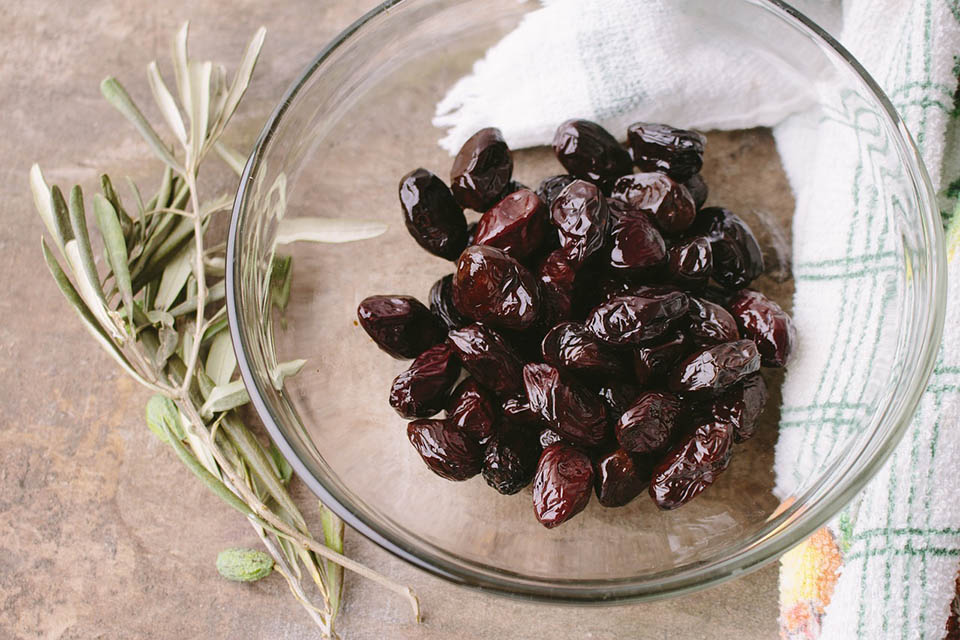
Table Olives and health: a review
The consumption of table olives in a moderate amount should be encouraged in the context of a healthy dietary pattern, as a snack or appetizer. Table olives have an important nutritional value due to their richness in MUFA, fibre, vitamin E and phenolic compounds.
“Table olives, a product of olive tree (Olea europaea L.), is an important fermented product of the Mediterranean Diet. Agronomical factors, particularly the cultivar, the ripening stage and the processing method employed are the main factors influencing the nutritional and non-nutritional composition of table olives and their organoleptic properties. The important nutritional value of this product is due to its richness in monounsaturated fat (MUFA), mainly oleic acid, fibre and vitamin E together with the presence of several phytochemicals. Among these, hydroxytyrosol (HT) is the major phenolic compound present in all types of table olives. There is a scarcity of in vitro, in vivo and human studies of table olives. This review focused comprehensively on the nutrients and bioactive compound content as well as the health benefits assigned to table olives. The possible health benefits associated with their consumption are thought to be primarily related to effects of MUFA on cardiovascular health, the antioxidant (AO) capacity of vitamin E and its role in protecting the body from oxidative damage and the anti-inflammatory and AO activities of HT”
SOURCE: National Library of Medicine > Table Olives and Health Article from Journal of Nutritional Science – provided courtesy of Cambridge University Press
NIH (National Institutes of Health) > NCBI (The National Center for Biotechnology Information: advances science and health by providing access to biomedical and genomic information)
SEE ALSO: Olive oil consumption and human health: A narrative review
Greek Table Olives and their Functional Value
“One of the most important commercial preparations of table olives in the international market is natural black olives in brine. Table olives are fruits with high nutritional and functional value. Apart from their nutritional value, olives also contain secondary compounds, such as phenolics, tocopherols, and triterpenes, which are frequently attributed with functional properties. This chapter discusses a number of studies focusing on the content of such components in table olives of Greek olive cultivars. Phenolics are a major category of components with important biological properties present in olive drupes. Apart from their contribution to sensory and aromatic characteristics of olives, they are also regarded as natural antioxidants due to their reducing properties as hydrogen- or electron-donating agents.”
WILLEY Online Library: Greek Table Olives and their Functional Value
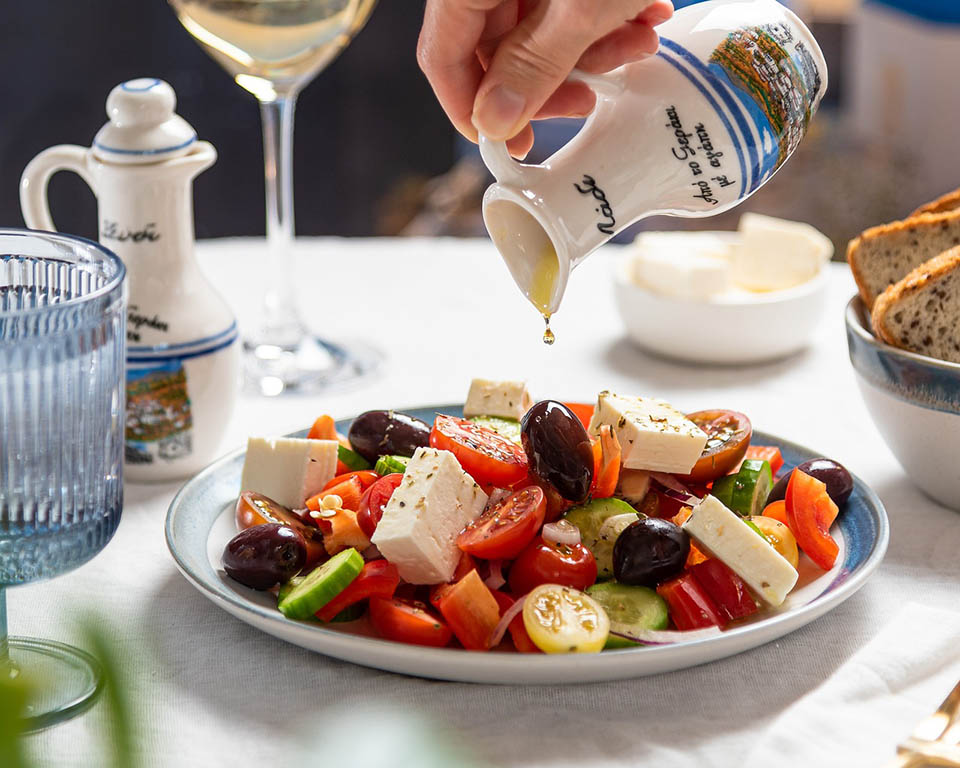
Greece travel food: Greek Table Olives and how to prepare them for your table
Articles related to Greek Table Olives
Olive Trees Species and Varieties
–
Different Types of Greek Olives
–
Different Types of Greek Table Olives varieties that are famously cultivated in Greece
–
The benefits of olive oil to human health
Olive oil offers health benefits as it is high in healthy monosaturated fats and antioxidants. It also has anti-inflammatory properties. The health effects of dietary fat are controversial. However, experts agree that olive oil – especially extra virgin – is good for human health. The 11 health benefits of olive oil that are supported by scientific research.
–
Table Olives More than a Fermented Food
Table olives are one of the oldest vegetable fermented foods in the Mediterranean area. Beside their economic impact, fermented table olives represent also an important healthy food in the Mediterranean diet, because of their high content of bioactive and health-promoting compounds.
–
Greece Hails Strong Presence in U.S. Table Olive Market as Exports Rise
Greece ranked second among table olives exporters to the United States in the first half of 2022 but received the highest prices (Source: Olive Oil Times).
–
CRITIDA’s premium Greek Table Olives products
–
Cook a classical feast: nine recipes from ancient Greece and Rome
–
Best Greek Salad Recipe: What’s the best olives to use?
–
How to make an authentic Greek Salad (Horiatiki), all you need to know about Greek Salad
GREEK TABLE OLIVES – Interprofessional Table Olives Organisation
The Interprofessional Table Olives Organisation (DOEPEL) was founded on 29.12.2014 in response to the pressing need for a specialised body to represent the Greek table olive sector- Greek Table Olives infographics
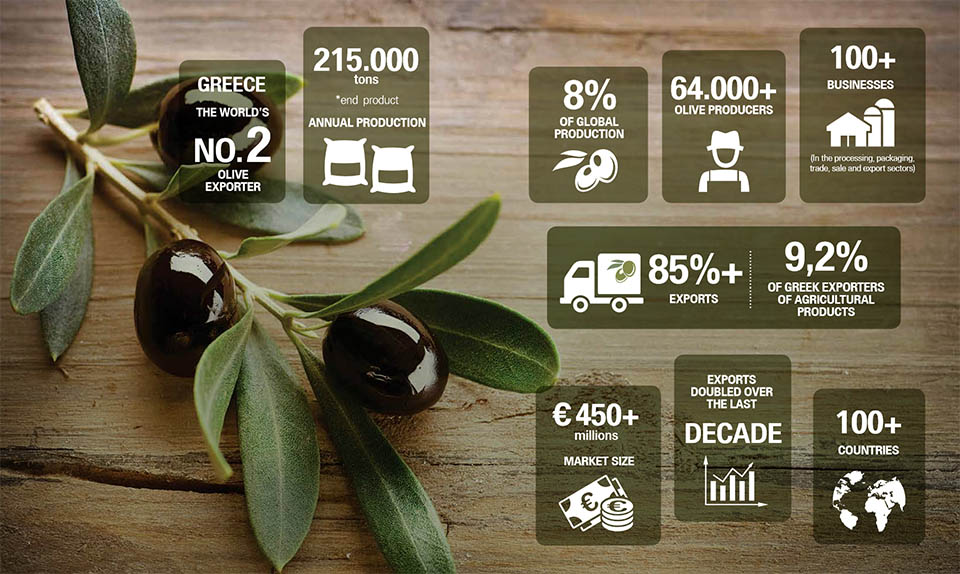
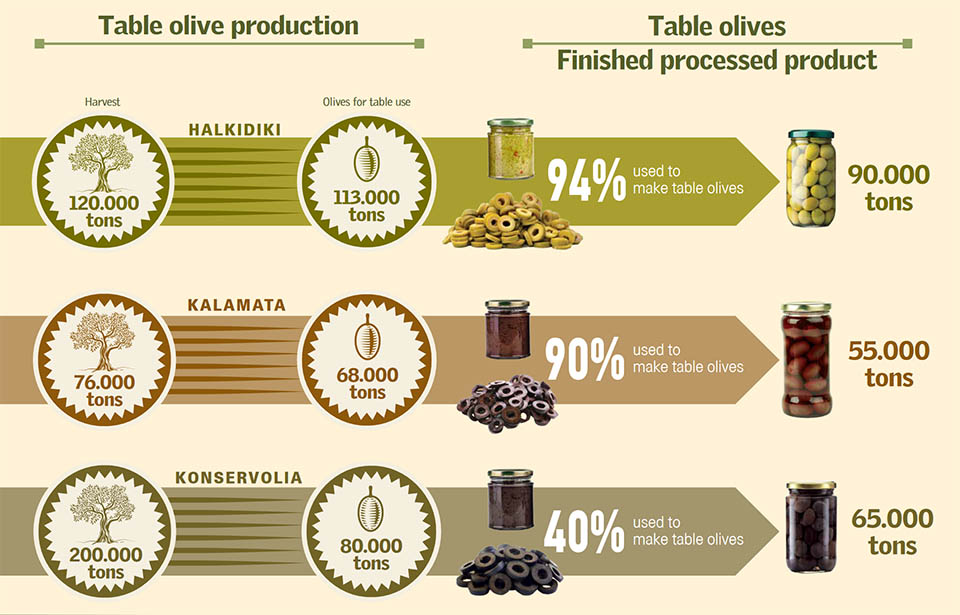
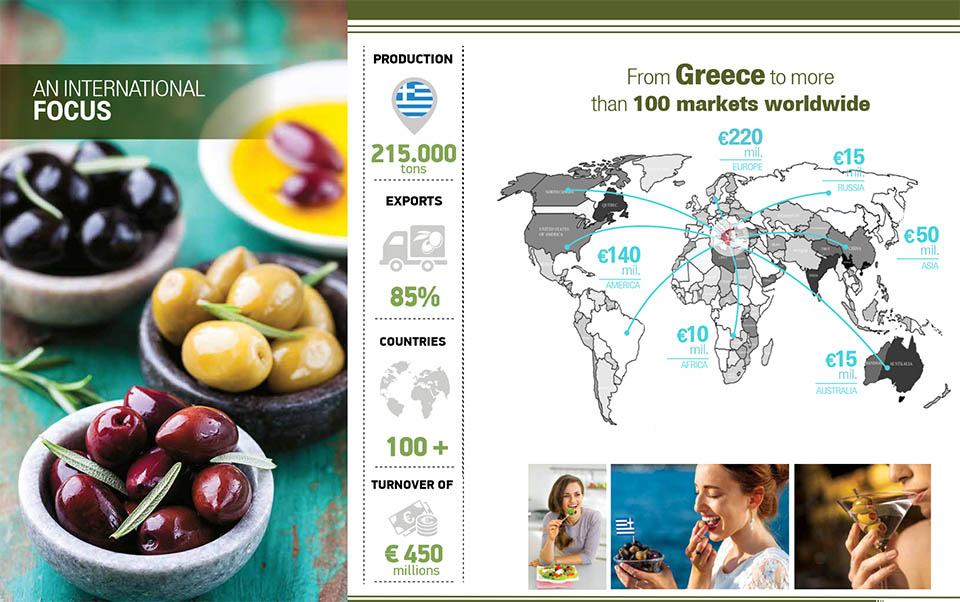
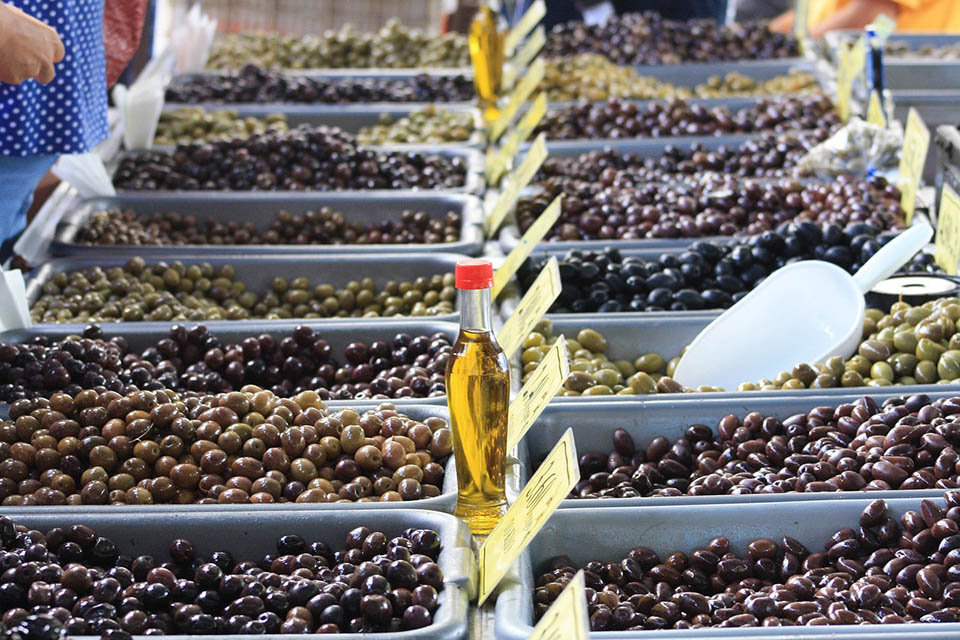
Olives Raisins – by Stella LoveCook
European Table olives Tasting Events in USA

CRITIDA BIO CRETAN OLIVE OIL - Producers of Premium Cretan Culinary Products: Our Food Products are EXPORTED WORLDWIDE to 40+ countries, since 1998 - Join Us!
We are a centuries-long family company (est 1912) in the production of EVOO Olive Oil on the island of CRETE in GREECE. Our Premium Cretan extra virgin olive oil and culinary food products are exported in 40+ countries worldwide to a carefully selected network of partners. CONTACT US, BE OUR NEXT VALUED BUSINESS PARTNER ! for Extra Virgin Olive Oil (EVOO) - Organic (Bio) Extra Virgin Olive Oil (Organic EVOO) - Greek Table Olives - Balsamic Vinegars - Delicatessen, all from CRETE GREECE
Related posts
Greek PDO and PGI Olive Oil products (list, specifications and info)
Info and facts about PDO and PGI Olive Oil products – Greek PDO and PGI Olive Oil products PDO
How long lasts a bottle of extra virgin olive oil?
For how long can extra virgin olive oil last – olive oil’s expiration date Good Greek ex
Tripadvisor: Crete 2nd best destination in the world for food in 2023
Crete is the second best food destination in the world for 2023 (TripAdvisor readers – Travell
Frying with olive oil
Is extra virgin olive oil suitable for frying dishes? Frying is one of the few characteristics commo

